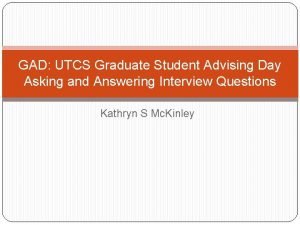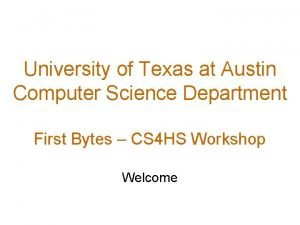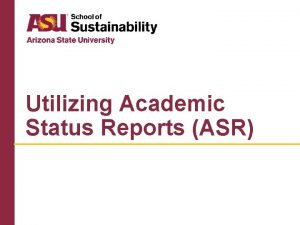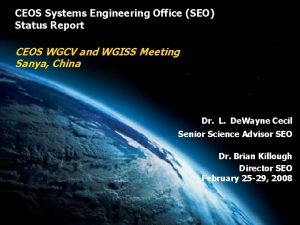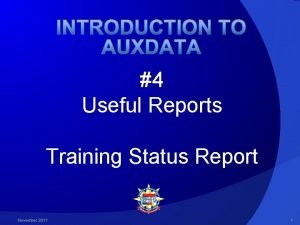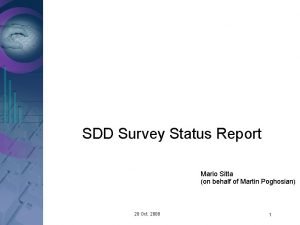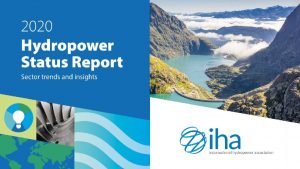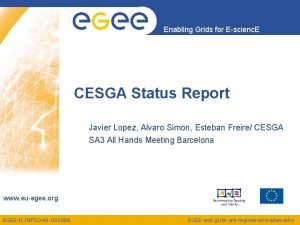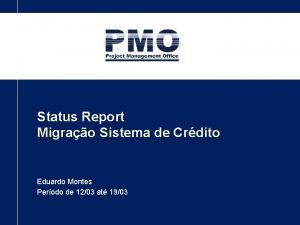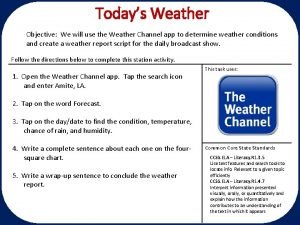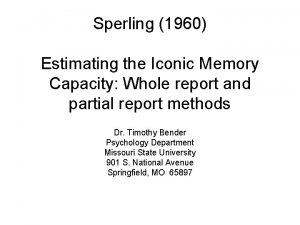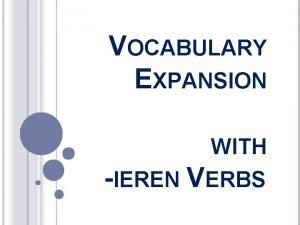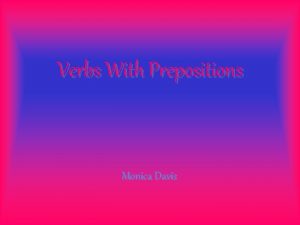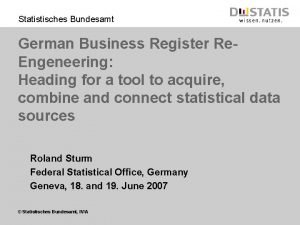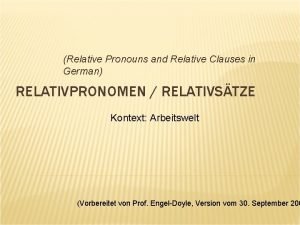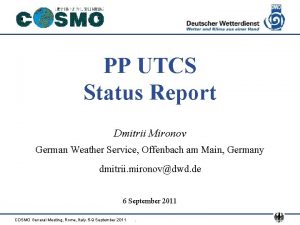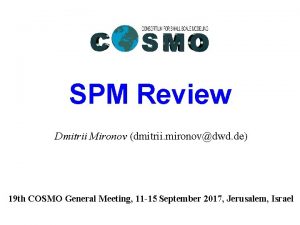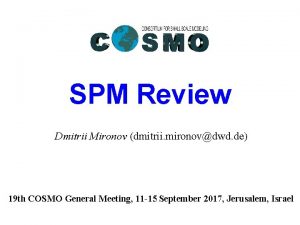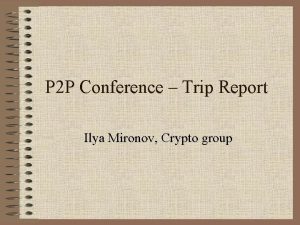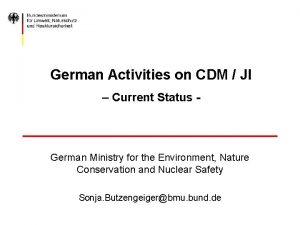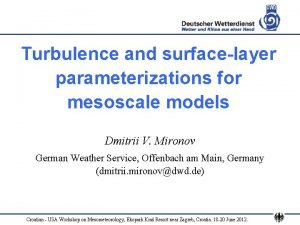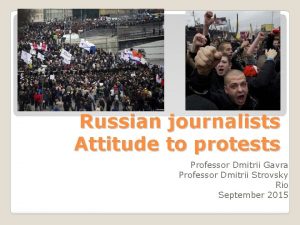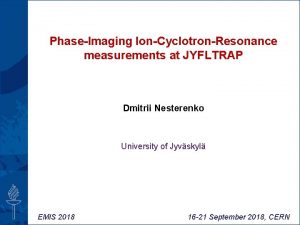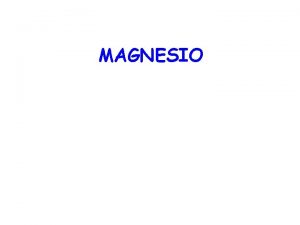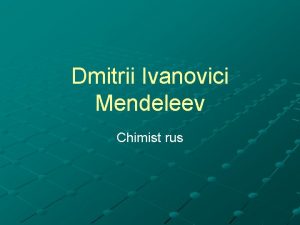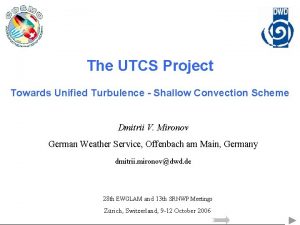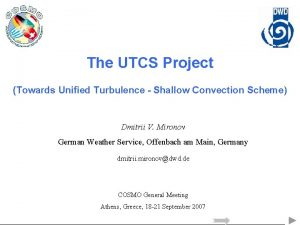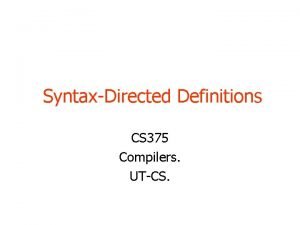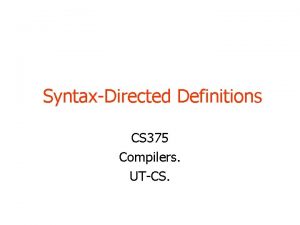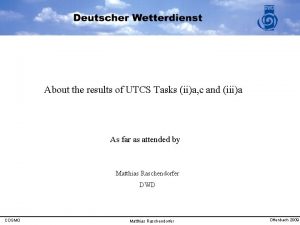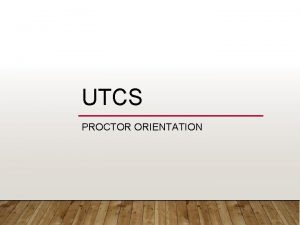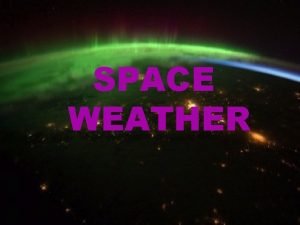PP UTCS Status Report Dmitrii Mironov German Weather







![= (dissipation)1/ out_usa_shs_rlme_a_shsr_0. 2 Pot. Temperature [K] out_usa_shs_rlme_a_shsr_1. 0 S increased turbulence activity due = (dissipation)1/ out_usa_shs_rlme_a_shsr_0. 2 Pot. Temperature [K] out_usa_shs_rlme_a_shsr_1. 0 S increased turbulence activity due](https://slidetodoc.com/presentation_image_h2/99e5d5d76de7ad54493a2f9b6c4a5191/image-8.jpg)






![turbulent kinetic energy [m^2/s^2] Lon -5 5. 5 Lat -5 6. 5 Effect of turbulent kinetic energy [m^2/s^2] Lon -5 5. 5 Lat -5 6. 5 Effect of](https://slidetodoc.com/presentation_image_h2/99e5d5d76de7ad54493a2f9b6c4a5191/image-15.jpg)






















- Slides: 37

PP UTCS Status Report Dmitrii Mironov German Weather Service, Offenbach am Main, Germany dmitrii. mironov@dwd. de 7 September 2010 COSMO General Meeting, Moscow, Russia. 6 -10 September 2010.

Outline è Overview of project results, plan for the next COSMO year (Dmitrii Mironov, ca. 30 min) è Further single-column testing and implementation into the COSMO model of the TKE-scalar variance secondorder turbulence-convection scheme (Ekaterina Machulskaya, ca. 30 min) COSMO General Meeting, Moscow, Russia. 6 -10 September 2010.

Task 2 a: Balazs Szintai Work Content • Comprehensive component testing of the current COSMOmodel turbulence scheme, using observational and LES data and 3 D model results (e. g. to specify 3 D corrections within the single-column framework) • Whenever possible, development of improved formulations of various components of the scheme

Task 2 a: Results • • • Dry convective PBL, comparison with LES data. Turbulent transport of TKE is too weak. As a consequence, TKE near the PBL is too low, leading to a too weak entrainment. Testing COSMO-model turbulence scheme in the LITFASS case. It is shown that the COSMO model is able to reproduce the main evolution of the boundary layer if the external parameters are realistic and if the initial conditions are adequate. However, the PBL depth is underestimated by the model, but at the same time thickness of the entrainment zone is overestimated, apparently due to a too coarse vertical resolution near the PBL top. Generally, COSMO produces a too shallow and too moist boundary layer. Horizontal Diffusion. Without horizontal diffusion the COSMO-1 simulation exhibits unrealistically strong waves in the PBL. Both physical (isotropic three-dimensional ) and numerical (fourth-order) horizontal diffusion have the same beneficial impact on the PBL structure. It is recommended to use three-dimensional turbulent diffusion scheme with horizontal mesh size on the order of 1 km. For flat convective conditions with very low horizontal wind field deformation, the Smagorinsky closure in its classical formulation generates too little mixing. Tuning vertical diffusion of TKE. With a (drastically) increased disposable coefficient in the downgradient TKE diffusion formulation, the PBL depth is in good agreement with observations. However, tuning should only be applied within PBL. Stably-stratified PBL. COSMO is able to simulate the gross properties of low-level jet if the minimum diffusion coefficients are reduced. The upside-down structure of the boundary layer is not captured by COSMO, however. (*) Balazs has left the project team, he is currently with the Hungarian Met Service. Thanks for excellent work and good luck!

Tasks 2 a, 2 c, 3 a: Matthias Raschendorfer Work Content • (2 a) Comprehensive component testing of the current COSMO-model turbulence scheme, using observational and LES data and 3 D model results (e. g. to specify 3 D corrections within the single-column framework); modification and further development, as needed, of the single-column (SC) version of COSMO • (2 c) Partial reformulation and consolidation of the current COSMOmodel moist turbulence scheme, including the surface-layer scheme • Re-organisation of the model code • Preparation of detailed documentation • (3 a) Modification of the SGS statistical cloud (condensation) scheme to account for the interaction of turbulence with deep convection described with the mass-flux approach

Task 2 a: Results (COSMO SC) • A consistent direct soil moisture correction due to measured evaporation is introduced (more sophisticated variational methods may be introduced later) • Some formal modifications were necessary in order to match the SC framework to COSMO version 4. 10 ff; these are introduced by Patrick Volker (beta version) [results from long term SC experiments will be described by Patrick Volker, DWDInnovationsprogramm, in his final report that is due in October 2010] • These and other modifications made by Patrick Volker still need to be merged with the reference version

Task 2 c: Results (Turbulence Scheme) • • Corrected version of implicit vertical TKE diffusion is now operational in COSMO-EU/DE Scale interaction terms due to (i) non-turbulent horizontal wind shear modes and (ii) orographic wake modes are implemented into the TKE equation; preparations (mainly of technical order) to verification, tuning and statistical analysis of results from experiments with modified equation are completed Within the framework of the CAT project • Association between measurement data on EDR (eddy dissipation rate) and GRIB data from model output is established • Offline calculations of complex turbulence indices related to the scale interaction terms are performed • Statistical analysis tools, including multiple regression for long data series with the application of conditional data filters, are implemented • Additional long term experiment parallel to the ADVISE experiment of DWD over the US is set up • Data files containing aircraft measurements and associated model data, including post processed turbulence indices, are generated • • First test runs and preliminary statistical analysis in order to fix scaling parameters, e. g. in the horizontal shear term, are performed Stability correction to the master turbulent length scale, mixed water/ice phase related to the SGS turbulence, and positive-definite TKE solver are implemented (testing is to be performed)
![dissipation1 outusashsrlmeashsr0 2 Pot Temperature K outusashsrlmeashsr1 0 S increased turbulence activity due = (dissipation)1/ out_usa_shs_rlme_a_shsr_0. 2 Pot. Temperature [K] out_usa_shs_rlme_a_shsr_1. 0 S increased turbulence activity due](https://slidetodoc.com/presentation_image_h2/99e5d5d76de7ad54493a2f9b6c4a5191/image-8.jpg)
= (dissipation)1/ out_usa_shs_rlme_a_shsr_0. 2 Pot. Temperature [K] out_usa_shs_rlme_a_shsr_1. 0 S increased turbulence activity due to horizontal wind shear COSMO 3 N frontal zone 06. 02. 2008 00 UTC + 06 h Matthias Raschendorfer -92 E Moscov: 06 -10. 09. 2010

= (dissipation)1/ 3 out_usa_rlme_sso out_usa_rlme_tkesso moderate light MIN = 0. 00104324 MAX = 10. 3641 AVE = 0. 126079 SIG = 0. 604423 out_usa_rlme_tkesso – out_usa_rlme_sso S MIN = 0. 00109619 MAX = 10. 3689 AVE = 0. 127089 SIG = 0. 804444 N mountain ridge SSO-effect in TKE budget increased turbulence activity due to generation of SSO wakes MIN = -0. 10315 MAX = 0. 391851 AVE = 0. 00100152 SIG = 0. 00946089 COSMO 06. 02. 2008 00 UTC + 06 h Matthias Raschendorfer -77 E Moscov: 06 -10. 09. 2010

Task 3 a: Results (Coupling turbulence and convection) • Formal separation of isotropic turbulence from convection within the framework of 2 nd order equations is completed [incl. application of double filtering, development of separate equations with scale interaction terms relating turbulence to non-turbulent sub-grid scale structures such as convection] • Proposal towards a reformulated scale interactive convection scheme is developed [incl. budget equations for 3 convective sub-domains in advection form, vertical velocity equation instead of mass flux equation, construction constraints defining the sub-domains instead of parameterization of dynamic de - and entrainment, boundary conditions for convective cells derived from turbulence properties instead of using artificial constraints, initial up- and downdraft at each level without a discrimination between deep and shallow convection, solution for convective volume fractions, intrinsic cut-off against turbulence and grid-scale convection, convective corrections of non linear source terms, overlap of turbulent (Gaussian) probability density for turbulent corrections of non linear source terms, convective source term for TKE (scale interaction term) being the related sink for convective kinetic energy by lateral mixing (de- and entrainment)]

Task 2 b: Veniamin Perov and Oleg Evteev Work Content • Comprehensive testing against observational and LES data of the new formulation of • • the non-local turbulence length scale through single-column numerical experiments Testing of the new length-scale formulation within full 3 D COSMO model Verification of results in different weather situations Results • An algorithm for computing the non-local turbulence length scale on the basis of parcel • • • displacement method is implemented; the new algorithm is more physically justified than the currently used algorithm based on the Blackadar formula The module TURBDIFF of the COSMO-model code is modified Comparison of model results with the radiosonde and profiler data is performed for the summer season Results show that the model with the new formulation for the turbulence length scale gives the temperature and velocity fields closer to the observational data as compared to the current COSMO-model formulation

700 Task 2 b: Results Vertical profiles of temperature in the boundary layer, for Vertical of Potential Temperatures Moscow, 12 h UTC, 12 h 17. 07. 2009 Dolgoprudnyj, UTC, 17. 09. 600 2500 2000 COSMO New Height, м 400 1500 Measurements from Profiler MPT -5 COSMO- REF 300 200 1000 COSMO reference Зонд COSMO NL 500 0 298 299 300 301 302 303 304 Potential Temperature, К 0 Vertical profiles temperature computed with 17 18 of (potential) 19 20 21 22 the current 23 (blue) and 24 new (red 25 – left panel, green – right panel) formulations for the turbulence length scale. Observational data Temperature, grad С are shown with the black (left) and red (right) curves. 26

Task 2 b: Results (cont’d) T 2 m difference (New L – Ref) for Moscow area, 17. 07. 2009 12 UTC

Task 3 b: Euripides Avgoustoglou (with Matthias Raschendorfer) Work Content • Systematic evaluation of the performance of the SGS cloud schemes (including water-ice mixed phase implemented by Matthias, see next slide) in terms of cloud cover, T 2 m, Td 2 m, and radiation budget at the surface • Critical assessment of the suitability of the statistical cloud scheme for use in radiation calculations Results • Various configurations/combinations of the SGS cloud schemes are tested (RH vs. statistical a lá Sommeria and Deardorff, different treatment of cloud ice, water-ice mixed phase at sub-grid scales) • Results are not conclusive but there are indications in favour of (somewhat) more physically plausible configurations
![turbulent kinetic energy m2s2 Lon 5 5 5 Lat 5 6 5 Effect of turbulent kinetic energy [m^2/s^2] Lon -5 5. 5 Lat -5 6. 5 Effect of](https://slidetodoc.com/presentation_image_h2/99e5d5d76de7ad54493a2f9b6c4a5191/image-15.jpg)
turbulent kinetic energy [m^2/s^2] Lon -5 5. 5 Lat -5 6. 5 Effect of SGS release of icing heat DWD Matthias Raschendorfer COSMO Cracow 2008

RH SGS_def © METEOSAT SGS_mix SGS_low SGS_RH

2 Jan 2005 RH SGS_def SGS_E-7 SGS_mix SGS_low SGS_RH Station #

observ RH SGS_def SGS_E-7 SGS_mix SGS_low SGS_RH

Task 1: Ekaterina Machulskaya and Dmitrii Mironov Work Content • Testing against observational and LES data and consolidation of a second-order closure • model of a moist PBL, including transport equations for the TKE and for the scalar variances and a sub-grid scale statistical cloud scheme for non-precipitating clouds Implementation of the best-compromise version of the new closure model (in terms of physical realism and computational stability and efficiency) into the COSMO model, testing within the single-column COSMO framework Results • Single-column tests show that the use of TKE-scalar variance scheme yields some improvements as to fractional cloud cover, second-moment profiles, and evolution of turbulence moments in time; a number of problems remain • Modified SGS statistical cloud scheme (effect of shallow cumuli following Bechtold et al. 1995) is tested through parallel experiments; scores are neutral to slightly positive • TKE-scalar variance scheme is implemented into three-dimensional COSMO model, parallel experiment is being performed, performance is monitored, results of verification will be reported later

Single-Column Tests: Shallow Cumuli skewed Gaussian Fractional cloud cover (upper row) and cloud water content (lower row) in BOMEX. Red – TKE scheme, blue – TKE-scalar variance scheme. Black solid curves in the middle figures show LES data.

Modified SGS Statistical Cloud Scheme Parallel Experiments (COSMO-EU) T 2 m over COSMO-DE domain in January 2010 (00 UTC forecasts). Red – Exp 7680, blue – COSMO-EU. Total cloud cover (left) and low-level cloud cover (right) over COSMO-EU domain in June 2010. Red – Exp 7692, blue – COSMO-EU.

LES and Modelling of SBL over Heterogeneous and Homogeneous Surfaces by D. Mironov, P. Sullivan (NCAR) and E. Machulskaya Blue – homogeneous SBL, red – heterogeneous SBL.

Tiled TKE-Temperature Variance Closure Model • Transport (prognostic) equations for TKE and for the temperature variances including third-order transport • Algebraic (diagnostic) formulations for temperature flux, for the Reynolds-stress components, and for turbulence length scale • Tile approach where different tiles have different surface temperature • Surface fluxes are computed as weighted means of fluxes over individual tiles • <w’ ’ 2> is non-zero at the surface in heterogeneous SBL • Input parameters of numerical experiments are similar to LES (except for piece-wise vs. sinusoidally varying surface temperature)

Tiled TKE-Temperature Variance Model: Results Blue – homogeneous SBL, red – heterogeneous SBL.

Plans for the Next COSMO Year Task 1. Ekaterina Machulskaya and Dmitrii Mironov • Consolidation of the TKE-scalar variance scheme (based on the results obtained in 2010) • Testing of the new scheme through numerical experiments within the framework of the full-fledged three-dimensional COSMO model, further single-column tests as needed • Analysis of results from numerical experiments, comparison with observational and numerical data, tuning of the new scheme • Preparation of documentation

Plan for the Next COSMO Year (cont’d) Task 2 a. Matthias Raschendorfer • Detailed component testing of the COSMO-model turbulence scheme with the COSMO-SC, using measurement data (for forcing and verification), 3 D-model results (for 3 D corrections), and LES results (for forcing, 3 D corrections and verification), with the main aim to fix the scheme weaknesses • Further development of turbulence and convection schemes with the emphasis on the interaction of turbulence and convection Task 2 b. Veniamin Perov and Oleg Evteev • Generalization of non-local formulation of the turbulence length scale to account for moist processes (effect on phase changes on the scale of turbulence) • Comprehensive testing of a generalized formulation through single-column and 3 D experiments, verification of results Task 3. Euripides Avgoustoglou and Matthias Raschendorfer • Systematic evaluation of SGS cloud schemes, including water-ice mixed phase, against satellite data

Task 4: Work did not start Work Content • Comparison of the cloud condensate diagnosed by the sub-grid scale cloud schemes (statistical and relative-humidity) and by the grid-scale saturation adjustment procedure (following the prognostics equations for the cloud water and cloud ice) Expected Outcome • A prerequisite for improving/tuning the statistical SGS cloud scheme and for eventually improving the treatment of the could water and of the cloud ice with due regard for the sub-grid scale processes Martin Köhler (DWD, FE 14) plans to perform this work within the framework of ICON, COSMO will benefit

Summary èThe project results obtained so far look satisfactory, although problems remain (e. g. numerical stability, formulation of turbulence length/time scale, SGS cloud cover) èThe project is expected (hoped) to proceed according to the plan COSMO General Meeting, Moscow, Russia. 6 -10 September 2010.

Thank you for your kind attention! Acknowledgements: Peter Bechtold, Vittorio Canuto, Sergey Danilov, Evgeni Fedorovich, Jochen Förstner, Jean-Francois Geleyn, Vladimir Gryanik, Thomas Hanisch, Donald Lenschow, Chin. Hoh Moeng, Ned Patton, Pier Siebesma, Peter Sulluvan, Jeffrey Weil, and Jun-Ichi Yano. COSMO General Meeting, Moscow, Russia. 6 -10 September 2010.

Appendix

Performance of the COSMO Model Regarding PBL Clouds by Patrick Volker (DWD-Innovationsprogramm) Short summary of three-year DWD project (end date 1 October 2010) Results from the Analysis • The overall COSMO performance (mean over long time and/or large domains) with respect to PBL clouds and T 2 m is satisfactory, however, there are outliers, i. e. forecasts are occasionally very poor • COSMO has trouble maintaining low-level clouds during the forecast, particularly in stably-stratified boundary layer (SBL) • The SBL structure is not simulated well (mixing is too strong) • COSMO tends to produce 2 -delta function cloud-cover distribution (all or nothing) instead of fractional cloudiness • Good scores often come at the expense of (large) compensating errors, e. g. area-mean T 2 m bias • In the SBL, T 2 m is often (far) too high already at the beginning of the forecast

Performance of the COSMO Model Regarding PBL Clouds (cont’d) 6 -hour COSMO-DE forecast of low-level cloud cover (target times are 0, 3, 6, 9, 12, 15, 18 and 21 UTC) vs. the model initial state (vv=00). Points are the result of time and area averaging (09. 10. 201013. 10. 2010; 7. 3 to 13. 3 E, 48. 3 to 50. 3 N). An “optimal” forecast (with given initial state) would have all points lying on the diagonal dashed line. Low-level cloud cover from the 10. 12. 2008 COSMO-EU analysis. Data are averaged over the COSMO-DE numerical domain.

Performance of the COSMO Model Regarding PBL Clouds (cont’d) !!! 2 m temperature from the COSMO-EU analysis on 07. 10. 2009 (left) and 08. 10. 2010 (right).

Performance of the COSMO Model Regarding PBL Clouds (cont’d) Vertical temperature profile in the SBL. Left panel – measurements at MOL (Lindenberg), right panel – COSMO-EU 00 UTC forecast.

Performance of the COSMO Model Regarding PBL Clouds (cont’d) (Likely) Cause of Trouble and Proposed Remedial Measures • Minimum diffusion coefficient Kmin used within COSMO model are far too large • Reducing Kmin improves the stably-stratified PBL structure, including clouds, but produces negative (area-mean) T 2 m bias • Since the COSMO-model soil is too diffusive and too strongly coupled to the surface air layer (as data from MOL clearly show, but this may not be quite true for all points), it seems impossible to improve the SBL structure without changing/tuning the soil model parameters (e. g. heat transfer) • Sensitivity experiments with the single-column version of COSMO (e. g. perpetual year runs) suggest that the soil heat transfer is too strong in Lindenberg, but seems to be acceptable in Cabauw • Further experiments are necessary to appropriately adjust/tune parameters of the soil model (coupled to the PBL) and to account for the effect of soil moisture on heat conductivity

Performance of the COSMO Model Regarding PBL Clouds (cont’d) Vertical temperature profile simulated by the single-column version of COSMO with a reduced Kmin (0. 01 m 2/s). 12 -hour COSMO-EU forecast of low-level cloud cover (target times are 0 and 12 UTC). Routine vs. experiment with a reduced Kmin (0. 01 m 2/s). Points are the result of area averaging over COSMO-DE domain.

Performance of the COSMO Model Regarding PBL Clouds (cont’d) Vertical temperature profile near the soilair interface as suggested by measurements at MOL, solid line, vs. typical temperature profile in COSMO. Measured soil heat flux at 10 cm depth at Cabauw during 1987 (data points are 15 h apart) vs. results from simulation with the single-column version of COSMO forced with measured surface fluxes.
 Utcs advising
Utcs advising Vijaya ramachandran ut austin
Vijaya ramachandran ut austin Heavy weather by weather report
Heavy weather by weather report Low german vs high german
Low german vs high german Writing a status report
Writing a status report Weather symbols for station models
Weather symbols for station models Summer tongue twisters
Summer tongue twisters Her poem clothing
Her poem clothing Cold cool
Cold cool Whether the weather
Whether the weather Capital weather gang weather wall
Capital weather gang weather wall Asu academic status report
Asu academic status report Work status report from doctor
Work status report from doctor Code pink kaiser
Code pink kaiser Vendor status report
Vendor status report Convercent report status
Convercent report status Seo status report
Seo status report Triennial customs broker fee
Triennial customs broker fee Training status report
Training status report Definition of rag status
Definition of rag status Annual status of education report
Annual status of education report Vertical mario
Vertical mario Hydropower status report 2020
Hydropower status report 2020 Status report
Status report Migrao
Migrao Weather report script today
Weather report script today Sperling 1960 iconic memory
Sperling 1960 iconic memory Why did the kaiser abdicate in 1918
Why did the kaiser abdicate in 1918 Ieren verbs german
Ieren verbs german German reflexive verbs with prepositions
German reflexive verbs with prepositions Pros and cons in german
Pros and cons in german German expressionist directors
German expressionist directors German business register
German business register Tipos de relative clauses
Tipos de relative clauses Relative pronouns in german
Relative pronouns in german German proxy server
German proxy server Ode to joy trivia
Ode to joy trivia Why were annemarie ellen and kirsti stopped by the soldiers
Why were annemarie ellen and kirsti stopped by the soldiers
